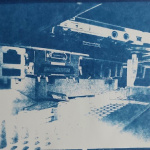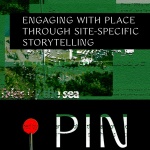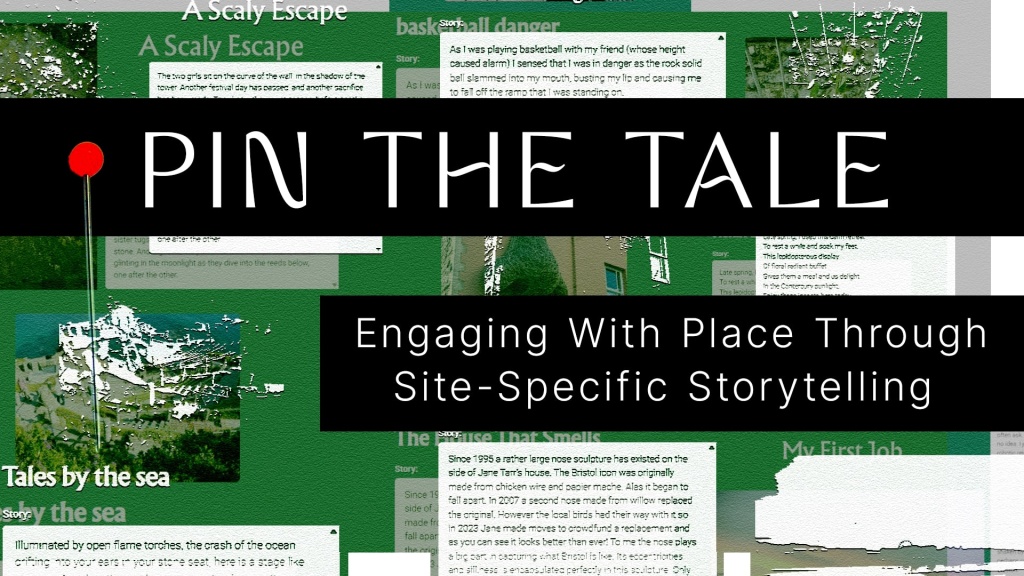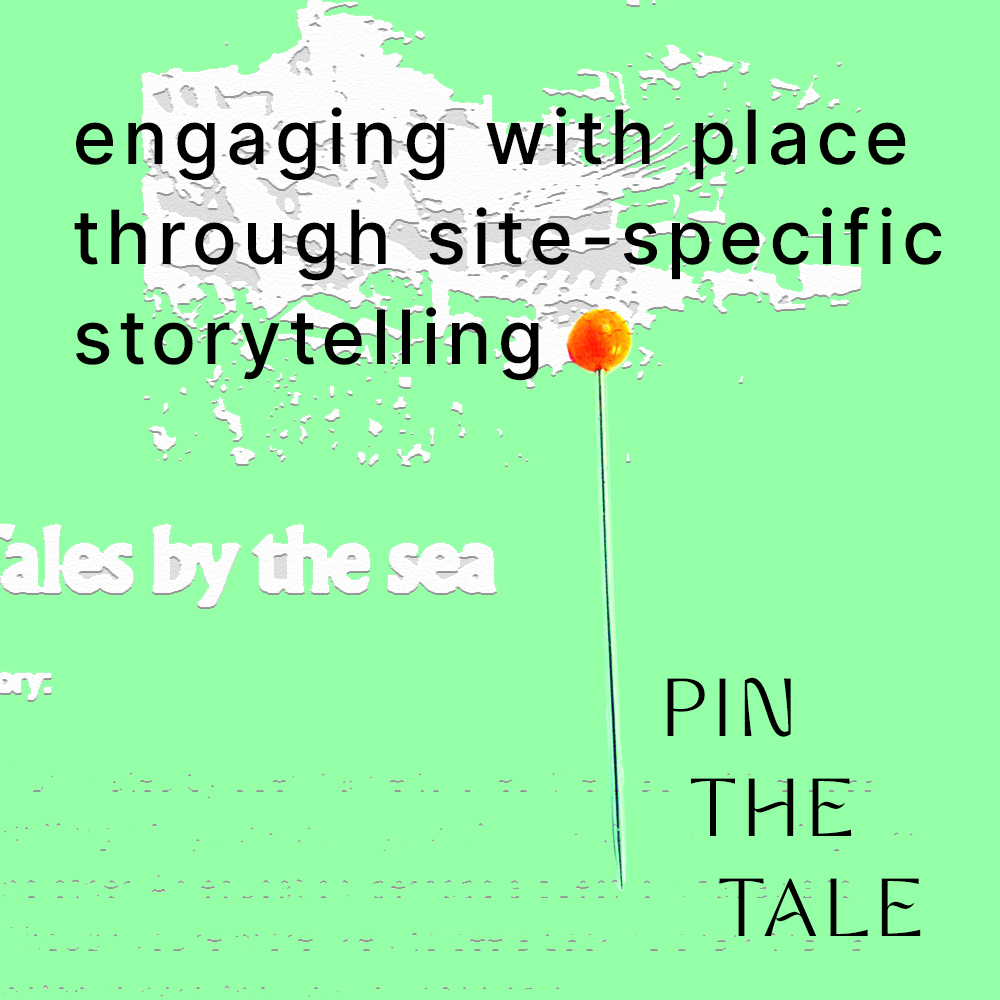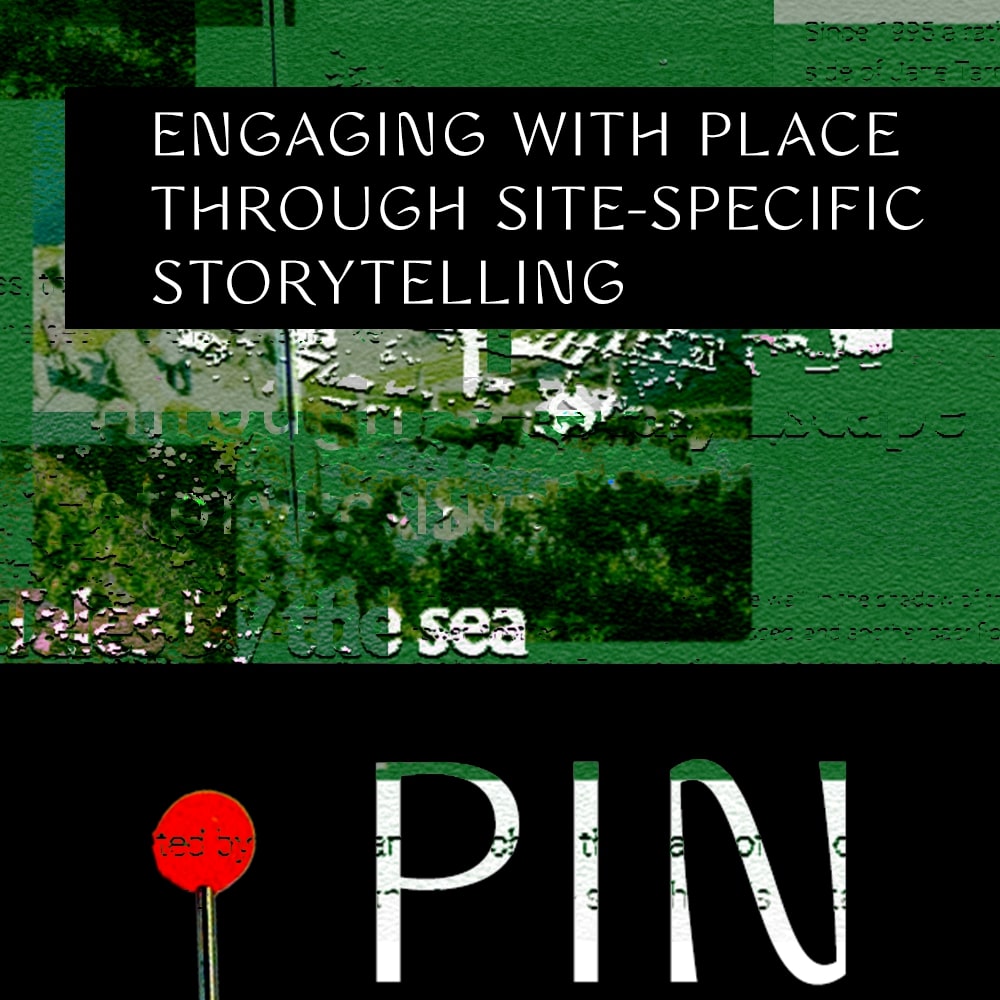Think about a place that is important to you.
What makes it important? Perhaps you have a powerful memory of the place. Or it is a place you have never been but hope to go. Or maybe it is a place that changed the course of your life.
Different types of places may have different resonances. What does a word like ‘home’ mean to you? Where do you picture when you think about a historic place? A peaceful place? A dangerous place?
Places are filled with these often-hidden significances to our lives. They are part of how we make sense of the world as humans; how we differentiate what might otherwise be abstract ‘space’ and turn it into something that has relevance to our lived experience.
Yet places are so integral to how we experience the world that we don’t often stop to think about where their significance comes from.
Pin the Tale is about pausing to consider exactly this. It is about connecting with everyday, human stories that speak of the meanings places have for us.
What is Pin the Tale?
Pin the Tale is an interactive, digital map that is designed to achieve a few things:
- To allow users to pinpoint particular places they have stories about
- To inspire users to tell these stories
- To enable users to discover stories other people have written
- To make the process of reading and writing site-specific stories engaging
One of the key features of the Pin the Tale map is its use of the what3words grid.
What3words is a geolocation system that divides the world into 3mx3m squares, giving each one a unique three-word address. On Pin the Tale, these words are used to tell stories about the places they are associated with.
The Pin the Tale map allows users to share stories about any place in the UK by finding its 3m x 3m square. You can see your current location on the map by enabling GPS, but don’t have to be in a location to write a story about it.
Key to writing these stories is that they must contain all three words of the places’ what3words addresses. Stories can be up to 300 words in length, though there’s no limit on the number of stories you can write. They can also take any creative form, including history, mythology, poetry or personal experience.
When sharing a story on Pin the Tale, there are a few other pieces of information you need to provide. You need to upload an image showing a detail that can be found at the location in the present day, as well as a short hint that will help people identify the location your story is about. Lastly, you need to select a difficulty rating, which reflects how recognisable the location would be to most people.
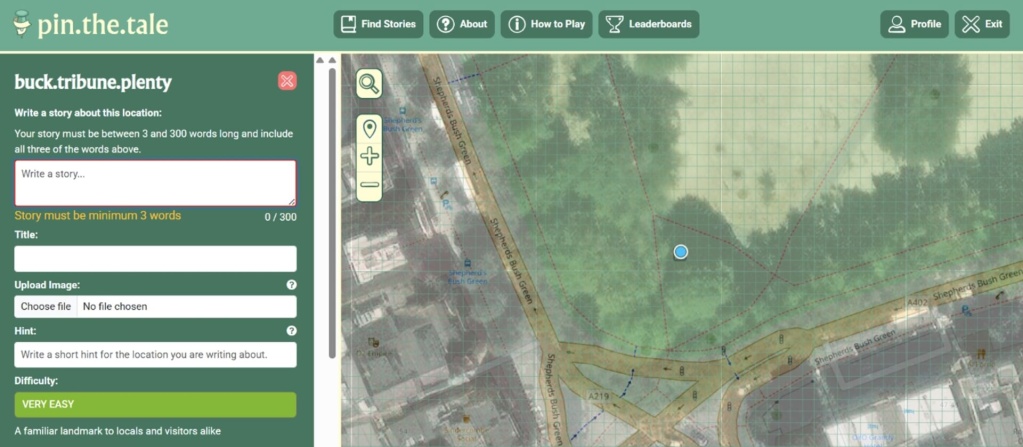
Screenshot from Pin the Tale, showing the story-writing interface
After submitting your story, it will be visible to anyone who visits the Pin the Tale map. And this is where the more playful, geo-guessing side of the game comes in.
It’s just like a treasure hunt. You navigate to an area of the map that you’re interested in. Then click the ‘Find Stories’ button to show all the stories written about the map area that’s visible on your screen.
After clicking on a story, you can use the information in the story text, the image and the hint to work out the exact location that the story is connected with. You’ll know when you’ve clicked on the right square because all the words in its 3-word address will be highlighted in the story text.
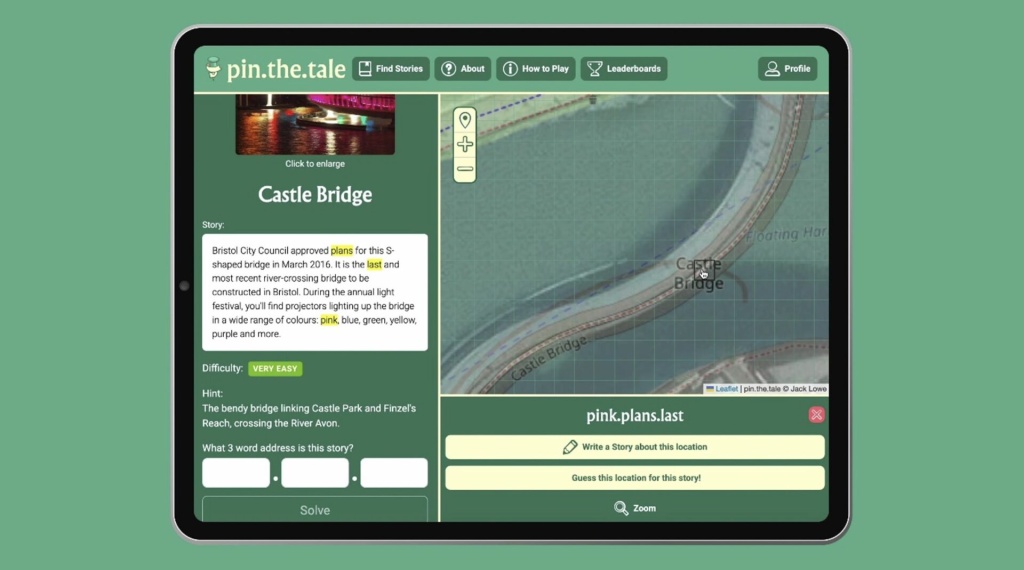
Finding the location of a story on Pin the Tale
Once you enter the square’s address into the answer box and click ‘solve’, the story is added to your collection of discovered stories. And there’s a leaderboard in the game that lets you compete against other players based on how many stories you’ve located.
How Pin the Tale Was Made
I built the initial prototype of Pin the Tale in 2020 during my PhD. This practice-based research project explored how the design and play of location-based games can enable people to engage with place.
The prototype was tested with a small group of 75 players in the city of Canterbury, Kent. It was run on a Facebook group, with people sharing their stories as posts in the group, and people commenting on the posts when they’d successfully identified each story’s location.
You can read more about this prototype and how it connects to my research on location-based games and place here.
However, I always thought that the basic framework of the game could work anywhere. I also noted several limitations of using a Facebook group to mediate the gameplay.
In 2024, I received funding from ESRC/AHRC SHAPE Catalyst, AHRC Impact Acceleration Account, and UKRI Higher Education Innovation Funding to develop a UK-wide version, working with a web developer and graphic designer to create a standalone browser-based version of the game.
The game launched in early-access in April 2025. It is freely available via mobile, tablet, PC and Mac at pinthetale.co.uk for people to contribute and discover stories anywhere in the UK.
How People Have Used Pin the Tale
The most common story types you’ll find on Pin the Tale are personal stories that reflect users’ individual, emotional responses to a place. They might be recounting experiences had there, highlighting details noticed about it, or broader reflections on what it means to them.
In this story from Weston-super-Mare, the author recounts their first job as a cleaner on the pier, and how working there helped them to come out of a shell of social anxiety. They talk about how a willingness to give a chance to young people with no work experience means that working on the pier is a rite of passage for many from Weston.
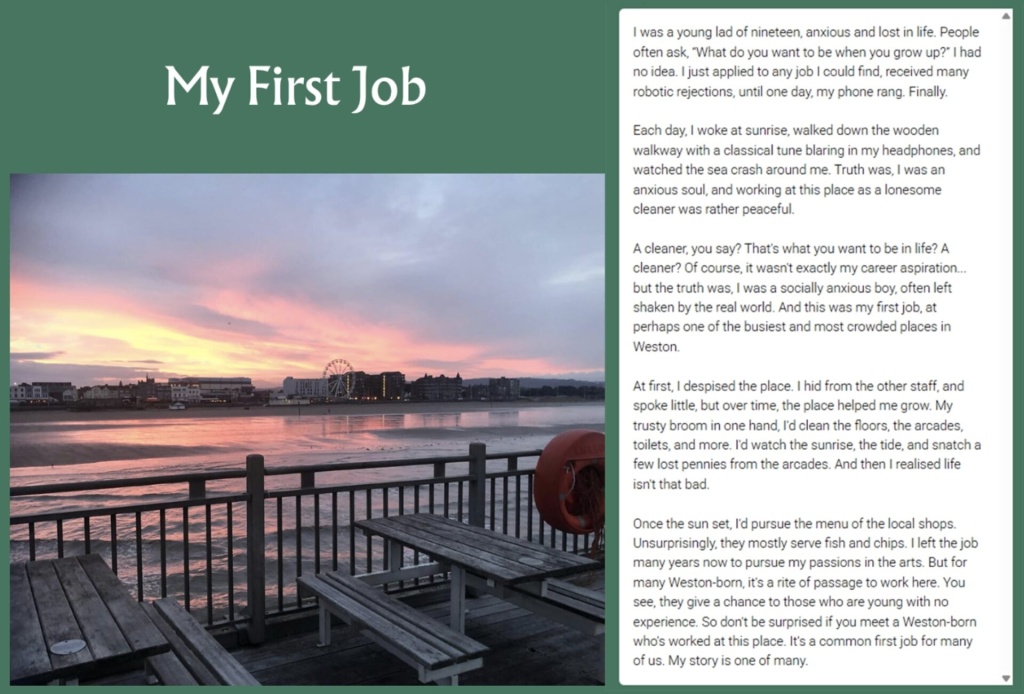
My First Job, a story shared on Pin the Tale by author ‘IMH’
It’s a story that reveals the impact that particular places can have on the trajectories of our lives. How they can come to symbolise moments or time periods that shape who we are as people.
More commonly, however, these individual reflections will be more fragmentary. Players have frequently recounted to me that the inspiration for their stories started by going through the photo gallery on their smartphones to remind themselves of places that they’ve visited. They will then find the precise what3words location on the Pin the Tale map and tell a story about the experience they had there.
These looser connections that we develop with place are nonetheless significant to how we make sense of the world in the contemporary technological context, and Pin the Tale provides a platform for sharing, revisiting and expanding on these site-specific associations.
That said, stories shared on Pin the Tale don’t have to be about personal experiences. Another common use case of the platform is what I call ‘signposting’: drawing attention to the unique features of a place, without necessarily reflecting on its individual significance for the author.
In the next two examples the authors use their stories to indicate the presence of a couple of unusual landmarks. Here, Pin the Tale is arguably playing a role akin to that of websites like Atlas Obscura, which deliberately direct people to ‘hidden gems’.
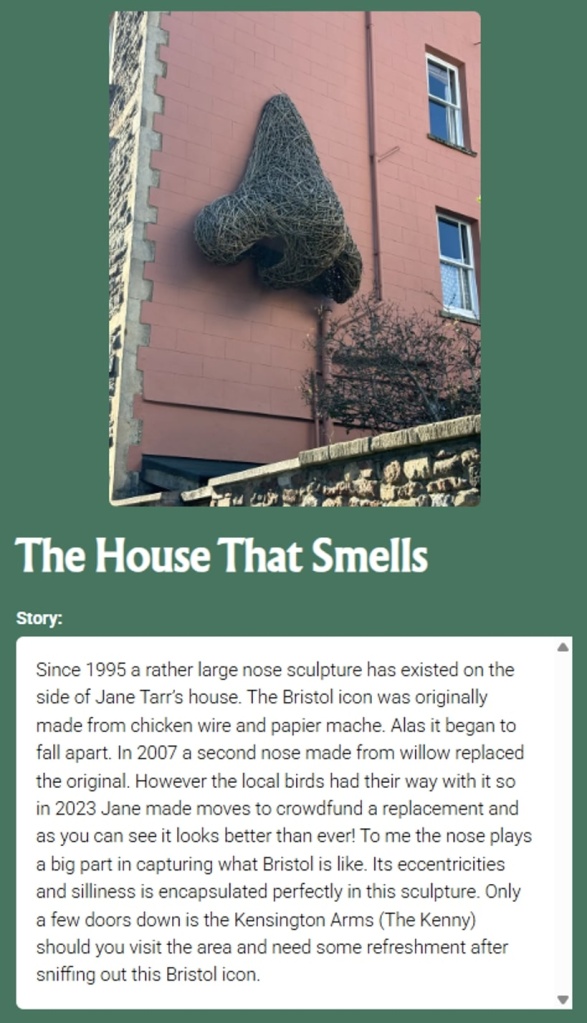
The House That Smells, a story shared on Pin the Tale by author ‘James Letherby’
Because these lesser-known aspects of places are represented equally with any other story shared on Pin the Tale – unlike other popular digital maps, which enforce a hierarchy of what appears on the map – the platform has the possibility of making visible aspects of culture and history which are usually less visible.
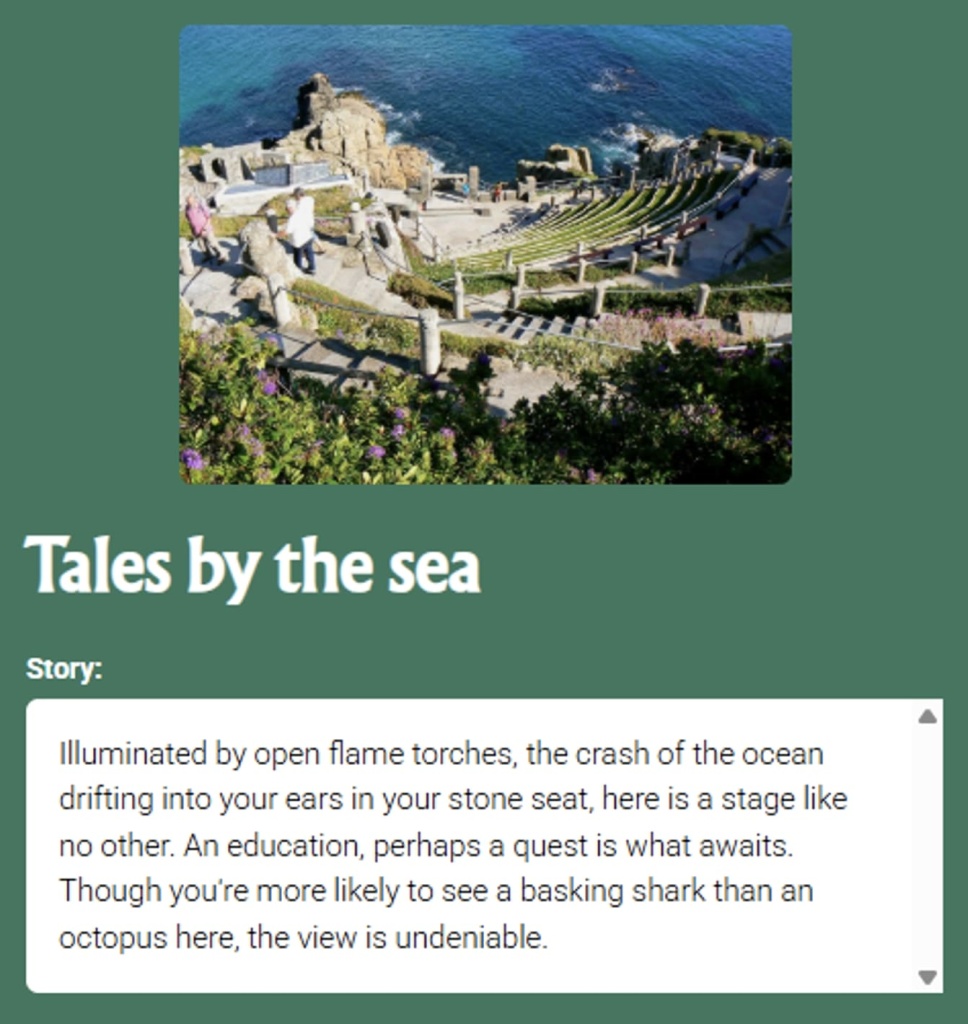
Tales by the sea, a story shared on Pin the Tale by an anonymous author
This includes what is commonly termed ‘intangible cultural heritage’: the living traditions, practices, knowledge and skills that are expressed by a community or group. The following story, which describes a Bonfire Night tradition in one village in Devon, reveals an element of place-based culture that you might not know about even when visiting the village, because it only happens one day of the year.

Ottery Tar Barells [sic], a story shared on Pin the Tale by an anonymous author
The examples I’ve shown so far illustrate the platform’s capacity for telling stories about what is actually in a place, or what actually happens or has happened there. But a significant proportion of stories on Pin the Tale take a more imaginative approach to writing about place, with the ‘random’ words acting as prompts for creativity in the form of poetry, fantasy and other types of fiction.
The author of the poem below explained to me that the what3words addresses provided an “inspirational structure” around which they could construct their verse. Despite not having written poetry since school, they would “suddenly get inspired as to how to write a line with that word in, and then what I would need to do to make it rhyme and to have the meter.”
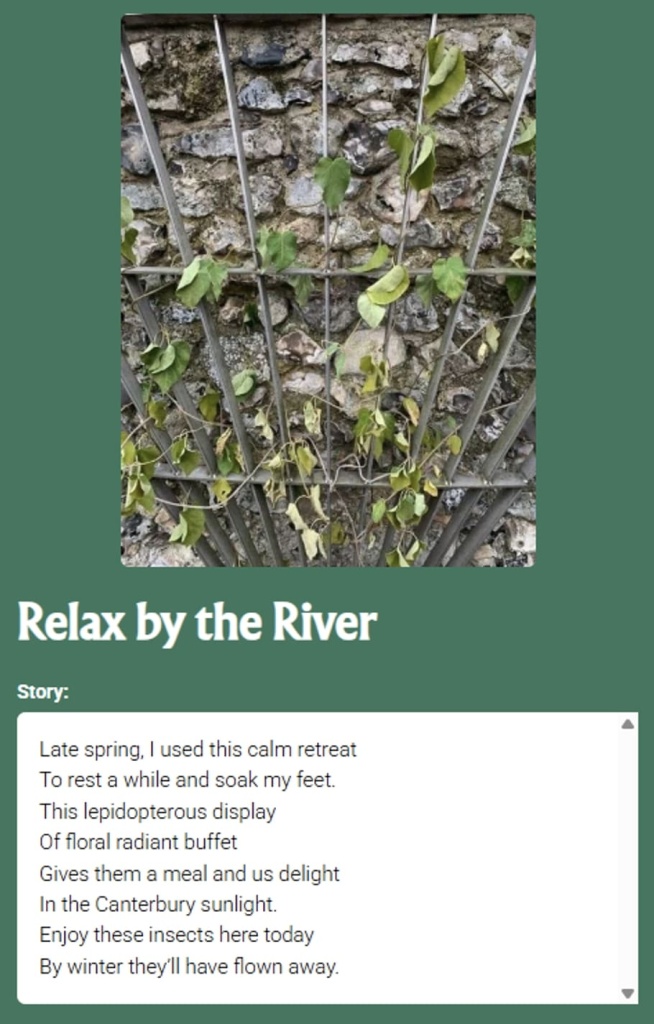
Relax by the River, a story shared on Pin the Tale by author ‘tom’
Similarly, the author of this fantasy story told me how the word ‘ritual’ took their story about humanoid statues on a riverbed in an unexpectedly dark direction:
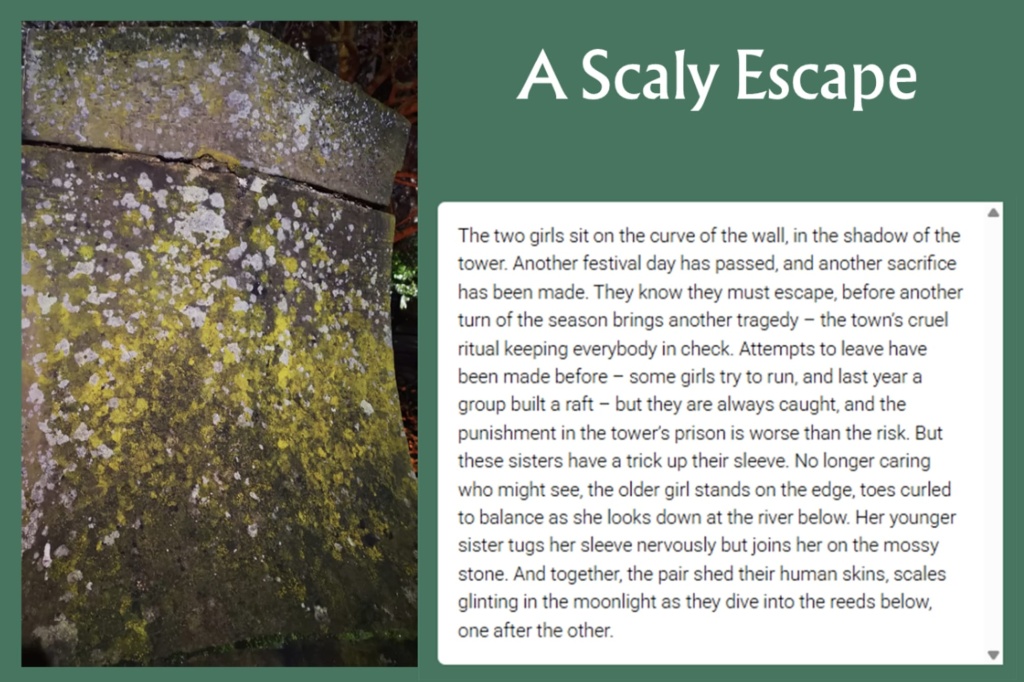
A Scaly Escape, a story shared on Pin the Tale by an anonymous author
In both the above examples, the authors were led by the address words themselves, at least as much as (if not more than) the places with which their stories were associated. The platform’s interface provided a framework for their creativity; a jumping-off point which offered a more stimulating experience than writing from a blank page. And in turn, this type of engagement with Pin the Tale changed what the authors’ stories communicated about the places in question.
Critical engagement with place
Given that these seemingly random words can have such a big influence on how people perceive their relationships with places, it is worth discussing where they come from.
All what3words addresses are constructed from databases of 25,000 words in each language (40,000 in English, to cover sea as well as land). These wordlists are edited to remove words that are currently considered offensive and to remove as many homophones as possible.
These databases are the property of what3words. While it is free to use what3words to find any what3words address, to integrate the what3words grid into your own projects or products, you need to pay to use their API (application programming interface). The licensing of this API, particularly to large corporate clients such as satnav manufacturers, is how what3words make money as a business.
As outlined in this short video published in June 2025, what3words addresses use words because they are designed to be spoken. The argument is that other geolocation systems are often too complicated to communicate through speech, as they involve reeling off lists of numbers and possibly unfamiliar characters.
However, associating words with locations is not a neutral, insignificant process. Words have cultural connotations and these also change over time. For many people who use what3words, one of the first things they do is look up familiar locations and remark on the words assigned to them. Typically, the addresses will seem funny (in an absurd kind of way), suggestive or strangely apt.
The what3words grid is so effective as the underlying geolocation system of Pin the Tale precisely because words are significant to us on an everyday level. By adapting this proprietary, language-based system that was designed for commercial utility, Pin the Tale provides a freely-accessible tool for place-based creativity and discovery through stories.
While the use of words for geolocation lends itself to site-specific meaning-making, fitting the words into a story can be challenging. For example, if one of the words is a verb that ends in ‘s’, it makes it harder to write from a first-person perspective. Similarly, a verb in the past tense may make writing in the present tense more difficult.
In these scenarios, the limitations of the three-word address can be prompts for a more creative form of engagement with place. The writer may ask themselves: what if I write a story from a different perspective? What if I use imagery, rather than write literally? As some of the examples above show, this can lead you in unexpected but inspiring directions.
Experiences of discovery and changed perspective extend to the other side of Pin the Tale’s interaction, which is reading other people’s stories and identifying their locations on the map. Almost all users I’ve interviewed have described having an experience where they’ve learnt new things about familiar places, or become newly aware of a place they didn’t know about before, simply through reading other users’ stories and engaging in the ‘treasure hunt’ gameplay.
In particular, the non-hierarchical method of presentation on Pin the Tale lends itself to encountering stories that go beyond the established narratives associated with places. The platform does not dictate which stories should be considered more or less culturally valuable.
The story below was written by a teenage boy who attended a Pin the Tale showcase event. For me, this story demonstrates how each individual finds different elements of meaning in the places with which they interact. Because if you’re a teenager who enjoys messing around with your friends on a basketball court, this humorous story is exactly the kind of thing that’s going to be meaningful to you. But importantly, it’s represented equally with all the others shared on Pin the Tale.

basketball danger, a story shared on Pin the Tale by an anonymous author
When interviewing users of the platform, I’ve found that they frequently speak about how powerful it is to learn about the associations that places have for other people. One interviewee specifically mentioned the word ‘sonder’, which refers to an awareness that everyone is leading their own individual lives as the protagonists in their own story, and you are just a side character.
Reading stories on Pin the Tale, users get a sense of how everyone has their own personal connections with place, born from a unique set of relations. This thinking aligns with relational conceptions of place, such as the geographer Doreen Massey’s notion of place as a “multiplicity of trajectories” (in her 2005 book For Space), or Tim Ingold’s notion of places as “meshworks” of paths taken by different entities (in his 2007 book Lines: A Brief History).
By adapting the utilitarian premise of what3words’ language-based geolocation system, using the words and their associated 3m x 3m squares as tools for sharing site-specific stories without imposing hierarchies of cultural value, Pin the Tale can arguably enable more critical engagement with place as something developed through relations between diverse people and things.
Future Paths and Perspectives
At its heart, Pin the Tale is about helping to connect and re-connect individuals and communities with places they live in, visit or care about. It’s about going beyond ‘official’ or stereotypical stories of places; using participatory storytelling to foster experiences of place that are more intimate, inspiring and creative. From my research with the platform so far, I’ve found that the realisation that we are all involved in making and re-making places every day can go a long way towards re-enchanting people’s relationships with the world around them.
The platform is still very much in development. Features that are planned to be added in future include:
- Language selection: what3words’ API can be implemented in 60+ languages, but stories on Pin the Tale can currently only be written in English.
- Tagging: adding searchable tags to simplify the process of finding stories around particular themes or particular types of stories.
- Accessibility settings: voice-to-text/text-to-voice compatibility for storytelling, a high-contrast mode, keyboard-only navigation settings and easy-read text sizing options.
- Bespoke author profiles: to enable more personalised engagement with the authors behind the stories on Pin the Tale.
Since the platform’s launch, there have been a series of creative writing workshops, showcases and other events that use telling stories with Pin the Tale as a way for people to connect, imagine and discover together. The ultimate aim is to cultivate a community of people interested in and inspired by place.
If you’re interested in joining future events, and keeping up to date with Pin the Tale as it develops further, there is a mailing list you can join here


